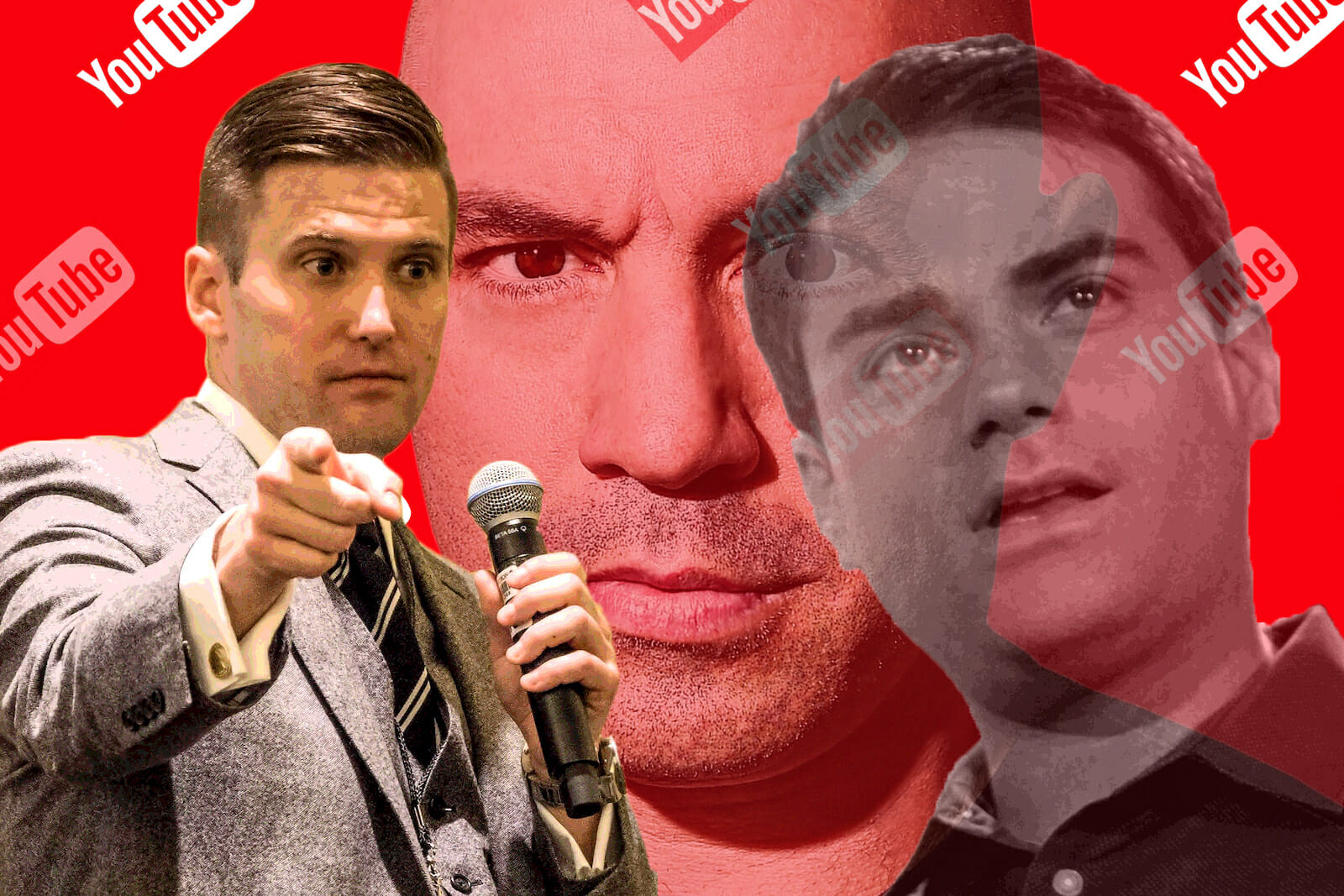
Tech
The Right Wing vs. the Left Wing on YouTube
There is a widespread perception that YouTube is a hotbed of unsavory ideologies and groups, particularly the far right. Obviously, advertisers are not too keen on having their ads placed next to extremist content. Does YouTube incentivize extreme right-wing content? A study that has been widely cited by sites like Vox and Wired as proof that the platform provides a breeding ground for far-right radicalization is a report by Rebecca Lewis of Data & Society.
It contains a list of people — from conservatives like the Daily Wire’s Ben Shapiro to white supremacists like Richard Spencer — who form the “alternative influence network,” a band of people supposedly linked together through their “reactionary” views, defined as an opposition “to visions of social progress” or social justice and left-wing politics more generally. By degrees, through this network users are exposed to more extreme content that they would otherwise not encounter. As Rebecca Lewis writes, it is highly interconnected, and uses “the same techniques that brands and other social media influencers use to build followers and garner traffic.” The report is written as if Lewis is investigating an underground crime network, but it is essentially an account of her YouTube binge and activism aimed at pressuring YouTube to censor her political opponents:
“The platform needs to not only assess what channels say in their content but also who they host and what their guests say. In a media environment consisting of networked influencers, YouTube must respond with policies that account for influence and amplification, as well as social networks.”
This “alternative influence network” (below) was discovered using the snowball approach — start with a small list of channels, then watch any visitors judged to be part of the same network. The size of the squares indicates how much they are a “conduit to other influencers” and the connections represent guest appearances and collaborations between channels.
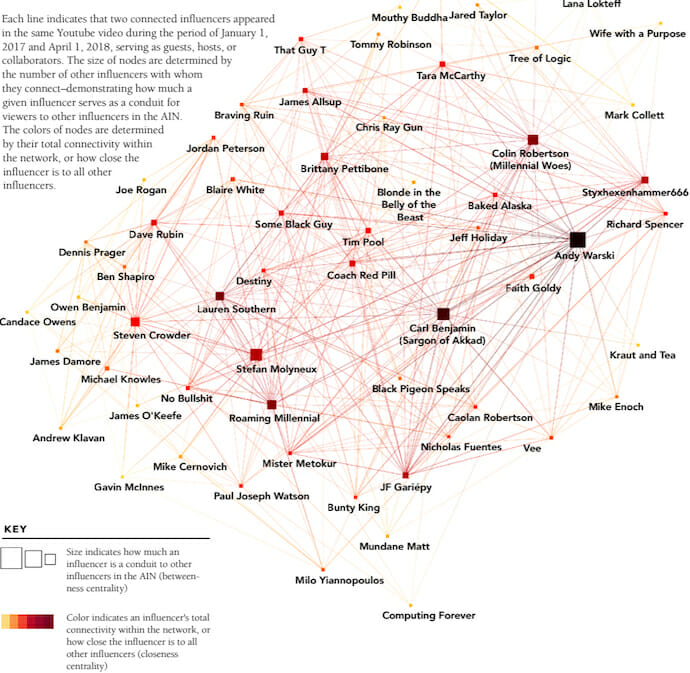 It is irrefutable that there is a large amount of right-wing, and even far-right content, on YouTube. But Lewis’ research seems to be premised on the blurring of distinctions. It finds links of association between people like Spencer and mainstream conservatives, and places them all under the same extremist label, despite the fact that their views may diverge in fundamental ways. The report perceives collaborative influence to encompass “debates and disagreements,” in which case it could equally conclude that influential people network with their influential opponents in order to debate ideas.
It is irrefutable that there is a large amount of right-wing, and even far-right content, on YouTube. But Lewis’ research seems to be premised on the blurring of distinctions. It finds links of association between people like Spencer and mainstream conservatives, and places them all under the same extremist label, despite the fact that their views may diverge in fundamental ways. The report perceives collaborative influence to encompass “debates and disagreements,” in which case it could equally conclude that influential people network with their influential opponents in order to debate ideas.
But the report does raise important questions about YouTube that are left unanswered:
- Are right-leaning commentators more influential on YouTube?
- Do the incentives of the YouTube platform guide users to more extreme content?
- Is the “reactionary right” a useful political label?
Here is my own re-creation of the network diagram that fixes some of the problems with Lewis’ research and focuses more on the YouTube platform itself, as opposed to a biased collection of political commentators that Lewis deems reactionary. I highly recommend looking at the interactive version, which lets you search for the connections and influence of individual channels.
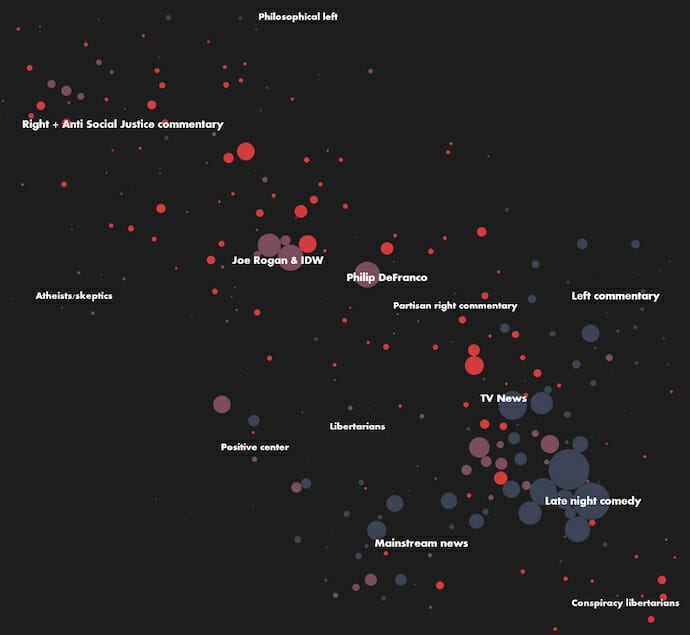 In the image above, each YouTube channel is represented by an individual circle placed so that channels with mutual recommendations cluster together. The size of the circle indicates the number of views received during the year. A “recommendation” is the appearance of another channels video in the recommended video sidebar that YouTube generates unique to each video and user.
In the image above, each YouTube channel is represented by an individual circle placed so that channels with mutual recommendations cluster together. The size of the circle indicates the number of views received during the year. A “recommendation” is the appearance of another channels video in the recommended video sidebar that YouTube generates unique to each video and user.
These recommendations are how YouTube as a platform exercises its influence over what video’s people watch. It is public, easily quantified information that can be collected automatically. It can also be made neutral — not biased towards previous viewing history — through YouTube’s API (Application Programming Interface). This is the interface people use to interact with YouTube through other software.
I did not record guest appearances because that tells us little about the influence of the YouTube platform itself and is difficult to reliably collect. There are a few caveats with my approach:
- I only included channels with significant focus on cultural commentary, or politics in the United States, which have more than 10,000 subscribers.
- Some judgment was required to find and classify channels. A detailed description of how that was done, source code and data is available here.
- Some political channels may be missing. Unfortunately, there is no way to reliably amalgamate all political channels.
Given the supposed existence of shadowy right-wing networks dominating YouTube, the results are surprising. These are the three most important lessons that go against what we have been told about YouTube’s influence:
The left dominates views, the right has more channels
I expected to confirm my belief that the right dominates YouTube, which is probably because they have a larger (and increasing) number of individual YouTube content creators. But the data shows that YouTube is predominantly left-leaning in terms of total views for 2018 due to political TV pundits from mainstream broadcasters — such as John Oliver and Trevor Noah — posting their content.
 YouTube recommendations are left/right neutral
YouTube recommendations are left/right neutral
This diagram shows the number of views in 2018 for each political category (left) and the recommendations as a portion of those views (right). Overall, recommendations are politically neutral, which is counter to the charge that the YouTube platform favors the reactionary right.
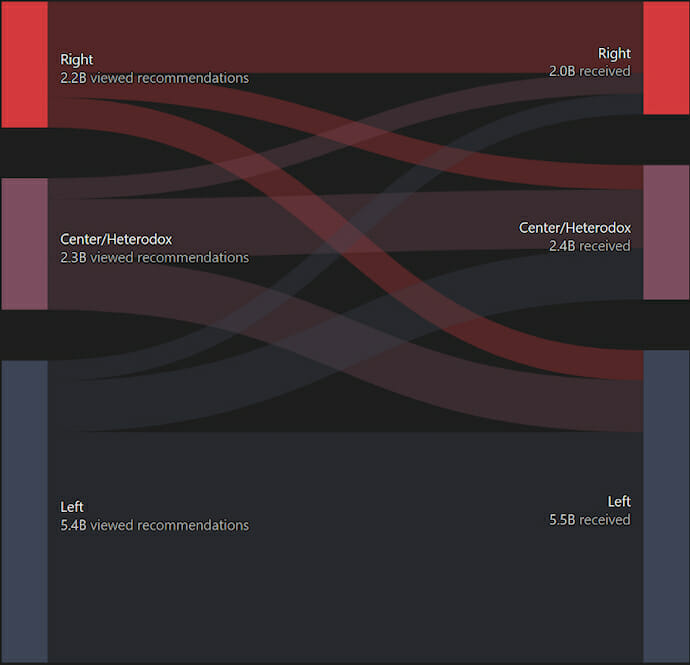 It’s unclear if the “reactionary right” leads to the far-right
It’s unclear if the “reactionary right” leads to the far-right
The claim that YouTube promotes more extreme views is tricky to analyze, because the boundaries that separate the ‘extreme’ from the merely controversial, or unorthodox, are subjectively determined. But my impression is that recommendations tend to flow the opposite way — from the less popular channels to the more mainstream. This supports what YouTube says about their algorithm:
- It favors recent, popular videos.
- Based on your profile (or the current video for anonymous access) it uses a predictive model, built to maximize the likelihood you will watch the recommended video to the end and enjoy it.
- Whether people are recommended more extreme content will depend on their viewing history. And even then, the preponderance of recommendations will be for popular, mainstream videos.
From reviewing the summary of recommendations between channels, it is clear that they reflect the polarized clusters of the people who watch them. It isn’t clear, though, whether YouTube recommendations actively increase existing polarization. Some studies have shown the opposite to be true — that exposing people to opposing views on social media can, in fact, increase polarization. For example, showing a Young Turks video to a Ben Shapiro fan might just as probably make them think worse of the left than better.
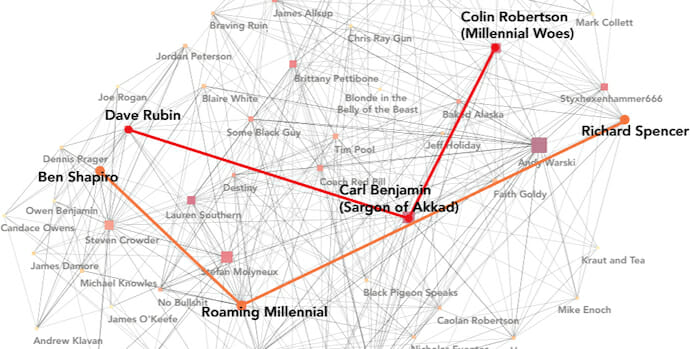 Dave Rubin seems to be at the center of the meta-discussion around political YouTube. The Data & Society report shows how he is connected to a white nationalist through mutual guest Sargon of Akkad.
Dave Rubin seems to be at the center of the meta-discussion around political YouTube. The Data & Society report shows how he is connected to a white nationalist through mutual guest Sargon of Akkad.
The path from any one person to another in any highly connected network is short, so picking this out is quite meaningless. To frame this in a more meaningful way, does Dave Rubin have recommended videos that lean more towards white nationalism? Here are the recommendation flows through the Rubin Report channel:
The Rubin Report both recommends and receives view recommendations from centrist and far-right channels, despite identifying as a classical liberal (libertarian). I don’t think this is proof he is secretly a conservative, but it does show that the audience cares more about which side you criticize than your political identity. Counter to the report’s narrative, the recommendation flows for Dave Rubin are a moderating influence — receiving more recommendations from the far right than it gives, while recommending mainly mainstream conservative and centrist channels.
Who are the “reactionary right”?
Ezra Klein and Rebecca Lewis agree on the distinguishing feature that unites the “reactionary right” tribe: “Many of these YouTubers are less defined by any single ideology than they are by a ‘reactionary’ position: a general opposition to feminism, social justice, or left-wing politics.” I agree that this is the main dividing line between the various political tribes of YouTube. There is very little discussion of taxation, environment, and other policy issues. Mostly discussions revolve around the culture wars, with a fundamental split on the issue of social justice.
But I think the Data & Society report has created a definition for the “reactionary right” for the purpose of problematizing them rather than as a useful label for understanding the political dynamics. Anything outside of a narrow progressivism, anything that is deemed to conflict with the goals of social justice and left-wing politics, is the target. Not only does this reject the idea that the Left can also be opposed to these things, but their definition is so broad as to include a great swathe of Americans.
The Hidden Tribes Report from More in Common surveyed a representative sample of 8,000 Americans and — using a cluster analysis — created seven broadly representative political tribes: devoted conservatives, traditional conservatives, moderates, politically disengaged, passive liberals, traditional liberals and progressive activists. Progressive activists make up only 8% of the population, and on issues concerning political correctness, they stand alone. The below YouGov poll from 2016 shows that most Americans also align with the “reactionary right” on cultural appropriation.
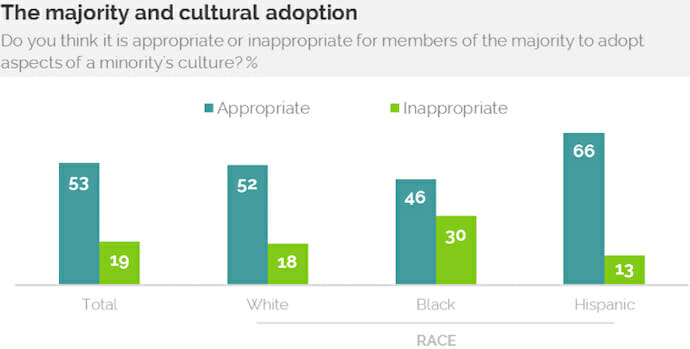 Although I do not believe YouTube incentivizes extremism, or that YouTube is predominantly right-wing, I still believe that the debate surrounding social justice issues could be less divisive. There seems to be a higher proportion of reactionary anti-social justice content compared to other platforms, and many YouTubers focus on the most extreme actions of progressive activists — unfairly labeling this as indicative of “the left.” Most of YouTubers are reacting to the issue of the day, especially when their out-group does something outrageous. You also see the same from leftist Youtubers.
Although I do not believe YouTube incentivizes extremism, or that YouTube is predominantly right-wing, I still believe that the debate surrounding social justice issues could be less divisive. There seems to be a higher proportion of reactionary anti-social justice content compared to other platforms, and many YouTubers focus on the most extreme actions of progressive activists — unfairly labeling this as indicative of “the left.” Most of YouTubers are reacting to the issue of the day, especially when their out-group does something outrageous. You also see the same from leftist Youtubers.
Despite this, calls for censorship, such as are implied in the Data & Society report, are intolerant, partisan, and extreme. Their targets include centrist and mainstream right commentators (e.g. Joe Rogan, Ben Shapiro, Dennis Prager) and they offer no viewpoint-neutral rules of what an acceptable YouTube video is. The justification offered is that their videos are “harmful” — a concept that has crept so far that it is almost meaningless. Indeed, the harmfulness of a video seems to be a factor of the viewer’s politics more than the video itself.
I think our tribal instincts make politics on social media worse than expected, but I am hopeful that new social norms and effective platform “nudges” will develop. To do this, we all need to work hard to tolerate and empathize with people in our out-groups. I will do this right now and show some love to a few progressive activists. I would like to endorse the leftist channels of ContraPoints, Robert Wright and Ezra Klein (who is, in fact, the author of the Vox article I just disagreed with). They seem genuinely interested in ideas and have demonstrated a willingness to attempt good discourse outside their own tribes. This is what political YouTube needs more of.
